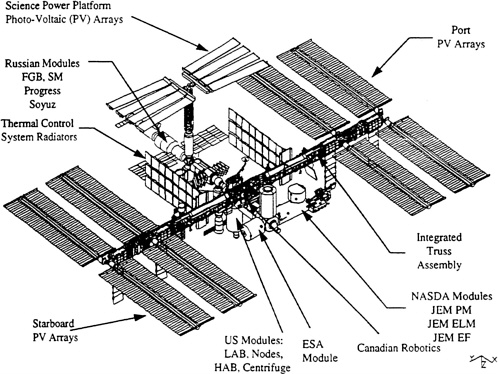1
Introduction
The first element of the International Space Station (ISS) is scheduled to be launched into a low Earth orbit (LEO) in late 1997. During the following five years, over 40 rocket launches from the United States and other countries will be used to deliver additional components to the station. When fully assembled, the ISS will have a mass of 419,000 kg, be longer than a football field, and have a full-time crew of six. Figure 1-1 depicts the ISS at the end of its assembly sequence. The current plan is to operate the ISS until at least 2012.
The ISS is being developed for a number of reasons, including the following:
-
to support long-term human exploration and development of space, and to demonstrate international cooperation in this complex and highly visible arena
-
to gain knowledge by performing scientific experiments in the unique environment of Earth orbit
-
to benefit the space programs and the economies of the countries that build and operate the ISS
Engineering research and technology development (ERTD), as part of the development and operation of the ISS and through directed experimentation on the ISS, will be the principal means of achieving the third goal. ERTD on the ISS could include research in diverse areas like advanced solar power systems and deployable lightweight structures, fluid transport, life-support systems, advanced remotely operated robotic systems, and verification of space environment and structural dynamics models. ERTD on the ISS could encompass (1) research on the behavior of the space station's structure and components during assembly and operation, (2) the development of technology to improve the capabilities of the

FIGURE 1-1 ISS completely assembled. Source: NASA
station, and (3) engineering research and technology development activities that use the ISS as a laboratory. For the purposes of this report, areas such as bio-medical sciences and materials processing are not considered to be engineering research or technology development. Even though engineering research and technology development would be required for such experiments, the experiments themselves would be aimed at answering scientific questions.
NASA has formally recognized the importance of engineering research and technology development on the ISS. ERTD was one of the three main research areas identified for the space station in its 1993 redesign, and the ISS's “Concept of Operation and Utilization” (NASA, 1994) includes technology development as one of the major operational missions of the ISS. Groups both within and outside NASA (NRC, 1985; SSTAC, 1987; SSTAC, 1991; President 's Advisory Committee, 1993; NRC, 1994) also have pressed for a vigorous ERTD program on the space station.
ERTD on the ISS could benefit the space program and the economy of the United States in a number of ways. Technologies developed or tested on the station, as well as knowledge gained from engineering research, could be used to improve the capabilities of the ISS and reduce its long-term operating costs. The
results could also be applied to other NASA and other government space programs, and might be adopted by industry for use in space or even on Earth. Finally, ERTD experiments developed by educational institutions could inspire and inform a new generation of students, who would be able to apply their knowledge to future space and Earth-based engineering activities.
Before these benefits can be gained, however, NASA must rethink its approach toward ERTD on the ISS. Effective use of the ISS as a facility for ERTD will require:
-
the development by NASA of a formal plan to use its own ERTD on the ISS to meet the country's larger needs in space
-
elimination or reduction of barriers to cheaper and faster performance of university and industry ERTD activities on the ISS
-
modification of ISS resource allocation procedures to enable commercial ERTD activities
-
broad dissemination of the results of space station ERTD
This report seeks to provide guidance on how these ends could be achieved.
REFERENCES
NASA (National Aeronautics and Space Administration). 1994. Concept of Operation and Utilization, International Space Station Alpha Program. Volume 1: Principles. SSP-50011-01 Rev B. October 19, 1994.
NRC (National Research Council). 1985.Space Station Engineering and Technology Development. Aeronautics and Space Engineering Board Panel on In-Space Engineering Research and Technology Development. Washington, D.C.:National Academy Press.
NRC (National Research Council). 1994. Letter Report to the Honorable Daniel S. Goldin. Aeronautics and Space Engineering Board Committee on Space Station . May 6, 1994.
The President's Advisory Committee on the Redesign of the Space Station. 1993. Final Report to the President. Charles M. Vest, Chair. June 10, 1993.
SSTAC (Space Systems and Technology Advisory Committee). 1987. Report of the Ad Hoc Committee on the Use of the Space Station for In-Space Engineering Research and Technology. July 1987.
SSTAC (Space Systems and Technology Advisory Committee). 1991. Report of the Ad Hoc Subcommittee on the Use of Space Station Freedom for In-Space Technology Development and Engineering Research. May 21, 1991.



